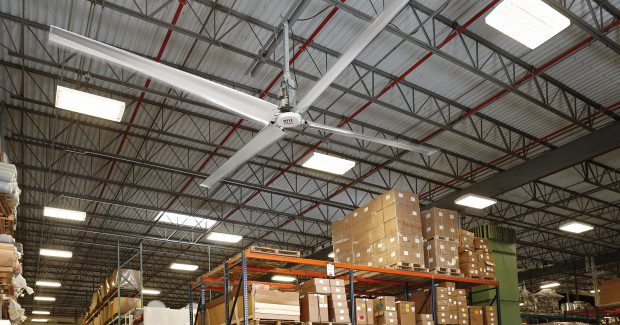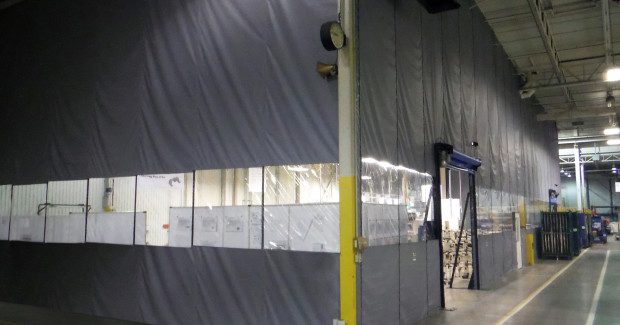How HVLS Fans and Curtain Walls Improve Indoor Air Quality
The containment of dust and other air particulates generated by cutting, grinding and welding is one of the biggest quality and safety challenges in the metalworking industry. Problems caused by in-plant dust/particulates are a dangerous issue to ignore, so here are two cost effective ways to address them.
Posted: November 13, 2015
The containment of dust and other air particulates is one of the biggest quality control challenges in the metalworking industry. A common byproduct of operations like cutting, grinding and welding, air particulate can also cause a host of safety issues. Given the range of potential problems it can cause, in-plant dust/particulates are a dangerous issue to ignore, and virtually any company engaged in a process handling or particulate generating operation will benefit from proper control practices.
ISSUES ARISING FROM AIR PARTICULATE
At best, dust on neighboring equipment, furniture, office equipment, windows, and floors can cause a constant drain on cleaning and maintenance resources. At worst, however, uncontrolled particulate matter can spoil or degrade batches of differing critical materials and ruin products. Besides product quality concerns, immediate safety problems – including fires and explosions – can arise when there is a high enough concentration of airborne dust-sized particulate in an enclosed space. Additionally, long-term health concerns exist for employees working where airborne particulate is present. These risks can range from a skin, eye, or bronchial irritation to more serious issues for people with asthma. There’s even potential for particulates to cause lung diseases like cancer.
PROVEN METHODS TO CONTROL PARTICULATE CONTAMINATION
Various methods can be used to prevent particulate from one space contaminating another. The most common are exhaust separation and barrier separation. Exhaust separation methods all rely on moving a volume of air containing the contaminate particles. Each of these could be accomplished through the use of exhaust fans through ducts to create a negative air pressure environment. On the other hand, in a clean space that generates no particulates, but is adjacent to a particulate-intensive area, a positive air pressure environment is desired. In this case, filtered air would be pumped into the clean space, creating a positive air pressure within the space and preventing inwardly flowing air currents that could carry foreign particulate matter from the adjacent area.
In some cases, a simple partition or wall between a clean space and an uncontrolled ambient space (such as between a processing area and a loading dock) is an effective means of separation. If negative air pressure differential exists across the wall between the clean and ambient space, the wall acts as a physical barrier, blocking most of the foreign matter from crossing the barrier. Depending on the degree of particle separation required, and the need and frequency for traffic to move through the partition, a more effective solution would be to introduce a positive air pressure differential to the clean space, as described in the previous paragraph.
The smaller a space can be made, the smaller the exhaust equipment can be specified. Partitioning around a dust source takes full advantage of this relationship. Reducing the volume of the space to be exhausted means a smaller fan(s) can be used, which reduces total air movement. Lower air velocity through filter media increases the effective particle separation of the device. Additionally, lower airflow through the filter reduces the frequency required for change out or cleaning. However, due to constantly changing layouts common in metalworking facilities, permanent walls are rarely a good option.
FABRIC CURTAIN WALLS BOOST EXHAUST EFFICIENCY
Thanks to flexible, easy-to-install fabric curtain walls, facility managers now have a solution to effectively separate processing areas from clean/finishing areas. If and when the layout of the facility changes, curtain walls can easily be reconfigured to fit the newest needs. In a situation where a positive pressure space is desired, some sort of enclosure (or “box”) around the space would be optimal to maintain the pressure differential. Fabric curtain walls are an ideal partition solution as they are less expensive to install than hard walls and create an enclosure seal just as effective as a hard wall. In some cases they can be even more effective, particularly if there are many penetrations through the partition like piping, conduit, etc.
https://youtu.be/ym06AC_JSoc
The inclusion of standalone, high-speed roll-up doors in the curtain wall allows for efficient thoroughfare, while minimizing time the interior is open to the processing area. Infiltration could be further reduced by positively pressurizing the clean space. Additionally, fabric curtain walls act as a very effective physical barrier on their own, blocking transfer of particles from space to space. Curtain walls can be single-layer fabric or multi-layer insulated and can easily be fitted with clear vision panels for visual communication between spaces.
Curtain walls are flexible by nature, yet very durable. They can withstand contact from machinery or product, and simply “bend without breaking,” in contrast to a hard permanent wall. They are also relatively easy to reconfigure if a space needs to be enlarged, reduced, or the shape of the space footprint needs to change. No “deconstruction” is required. Fabric curtain walls are easily installed, can be simply trimmed around conduit, piping, ductwork, etc., and can be anchored to the floor to withstand pressure differential across them. Depending on the application, a curtain wall can be suspended from the room ceiling or can be supplied with a standalone framework to hang from. They are available as stationary units, as well as sliding (suspended from roller track), and can be fitted with strip curtains, personnel doors, or high-speed industrial doors for full range of access to the space.
HVLS FANS CAN PLAY A ROLE
Increasing ventilation rates and air distribution often can be a cost effective way to reduce indoor pollutant levels, as well. HVAC systems should be designed to meet ventilation standards in local building codes. However, many systems are not operated or maintained to ensure that these design ventilation rates are provided. Increasing air movement and ventilation often provides dramatic relief for workers that spend hours every day in production areas that produce air contaminants. HVLS fans can do this by dispersing concentrations of airborne contaminants, such as dust and remnants from cutting/grinding and welding operations.
In addition to improving overall air quality, HVLS fans can keep workers cool and more productive. Slight breezes of only 2 mph to 3 mph can provide a cooling sensation of 7 deg F to 11 deg F, which can provide significant relief for workers operating in hot welding, cutting or production areas. There are a number of factors to consider when deciding how and when to use HVLS fans, including obstructions such as pallet racks, machinery, product staging areas, personnel work areas, and overall building layout. Smaller diameter fans will be most effective in specific work areas or where installation space is limited. However, fans up to 24 ft diameter can cover much larger areas – up to 22,000 sq ft – and can move air further over any obstructions in the facility.
A FLEXIBLE AND ECONOMICAL SOLUTION TO AIR PARTICULATE CONTROL
Curtain walls can be a smart choice for facilities looking to control particulate contamination. As a flexible and economical way to partition space, they make exhaust, supply, and separation systems for air particulate more efficient – regardless of the application. While curtain walls can help contain air particulate and enhance HVAC efficiencies, HVLS fans are a cost effective way to provide optimal airflow and particulate dispersion in the large open spaces that exist in many metalworking facilities.
Author Disclaimer
The information herein is provided as a general reference regarding the use of the applicable product(s) in specific applications. This information is provided without warranty. It is your responsibility to ensure that you are using all mentioned products properly in your specific application and in accordance with all laws and regulations.






